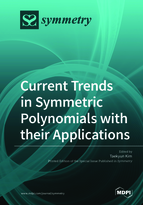Current Trends in Symmetric Polynomials with their Applications
A special issue of Symmetry (ISSN 2073-8994). This special issue belongs to the section "Mathematics".
Deadline for manuscript submissions: closed (28 February 2019) | Viewed by 57147
Special Issue Editor
Interests: number theory; analysis and applications; stochastic process
Special Issues, Collections and Topics in MDPI journals
Special Issue Information
Dear Colleagues,
The symmetric polynomials have various applications in many branches of mathematics and mathematical physics. These polynomials are defined by linear polynomials (differential relations), globally referred to as functional equations that arise in well-defined combinatorial contexts, and they lead systematically to well-defined classes of functions. The symmetric functions for the sequence of polynomials are used in analyzing sequences of functions, in finding a closed formula for a sequence, in finding recurrence relations and differential equations, in relationships between sequences, in asymptotic behavior of sequences, and in proving identities involving sequences.
We aim to design this special issue for researchers with an interest in pure and applied Mathematics. This special issue aims to present theory, methods, and applications of recent/current symmetric polynomials.
Each paper that will be published in this special issue aims at enriching the understanding of current research problems, theories, and applications on the chosen topics. The emphasis will be to present the basic developments concerning an idea in full detail, and also contain the most recent advances made in the area of symmetric functions and polynomials.
Advanced research on symmetric functions and polynomials is essential to study and model various changes in their natures. We will attempt to include some carefully selected papers in these areas of research that have significant applications. Much applicable mathematics cannot be investigated further or used without the applications of symmetric special functions and polynomials.
Thus, this special issue is expected to be beneficial for researchers who are interested in mathematics that has applications in pure and applied mathematics and uses tools mainly from the broad mathematical grouping.
Prof. Taekyun Kim
Guest Editor
Manuscript Submission Information
Manuscripts should be submitted online at www.mdpi.com by registering and logging in to this website. Once you are registered, click here to go to the submission form. Manuscripts can be submitted until the deadline. All submissions that pass pre-check are peer-reviewed. Accepted papers will be published continuously in the journal (as soon as accepted) and will be listed together on the special issue website. Research articles, review articles as well as short communications are invited. For planned papers, a title and short abstract (about 100 words) can be sent to the Editorial Office for announcement on this website.
Submitted manuscripts should not have been published previously, nor be under consideration for publication elsewhere (except conference proceedings papers). All manuscripts are thoroughly refereed through a single-blind peer-review process. A guide for authors and other relevant information for submission of manuscripts is available on the Instructions for Authors page. Symmetry is an international peer-reviewed open access monthly journal published by MDPI.
Please visit the Instructions for Authors page before submitting a manuscript. The Article Processing Charge (APC) for publication in this open access journal is 2400 CHF (Swiss Francs). Submitted papers should be well formatted and use good English. Authors may use MDPI's English editing service prior to publication or during author revisions.
Keywords
- Symmetric polynomials
- Special Functions
- Special polynomials
- Inequalities
- Integral Equations,
- Mathematical Physics
- Bosonic p-adic integral
- Fermionic p-adic integral






